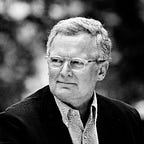Why management has to be algorithmic
The industrial firm was understood as a fairly simple, independent machine. The system was designed around the machine with tightly integrated supply chains, simple causality and the optimized use of coupled resources insulating it from shortages and resource stock-outs. Being efficient and productive inside the firewall was enough to prosper. The influence of external forces on business was not seen as significant, at least not before it was too late to do anything.
This kind of a system is, in biological terms, autopoietic (Maturana & Varela). The system is organizationally almost closed and often described as a whole. It means that the system’s organization is not determined by anything outside it. It may import energy, materials or information and export products and waste, but its identity is determined by its own operations and its own culture. Fully automated business entities called Decentralized Autonomous Organizations, are seen as the modern, network-based, computational versions of these same systems. Once DAOs are up and running, they don’t need anybody from outside to mess with them.
In engineering language, these systems are cybernetic. According to cybernetic theory, two forces drive action. The first is to achieve a chosen purpose and goals. The second is adaptation to changes that might otherwise derail the system from reaching its goals. The central problem of cybernetics is how to keep an organization on, or very close to, a desired path through feedback and self-regulation.
Cybernetics is the theory of control and management is the practice of control.
In psychology these same ideas were presented in the form that people do not simply respond to stimuli, but select aspects of their environment according to their own identities. People build the environment that is relevant to them. Each individual in a sense constructs her own world. This belief still drives personalization in services. It is also one of the reasons why the first phase of the Algorithmic Economy mainly deals with the personalization of content and marketing messages.
Billionaires were made, but what a waste of computing power and technological intelligence!
When biologists, engineers and psychologists developed these system theories, they were closely related to developments in computer technologies and the available computing power. This is still the case today. But now, the computing power and the algorithmic capabilities we have, are immensely more powerful, creating new opportunity spaces for science. The state of art in psychology is not any more in constructionism, but in relational models. Sociology is moving towards computational social science and sciences of complexity slowly create a very different understanding of causality than what was inbuilt in systems thinking.
Scientists study the digital codes of algorithms together with the chemical codes of biochemistry. Among the questions they have tried to answer are these: “What is the origin of order and coherent action in life?” “Is it common goals that species in nature subscribe to?” “Is it the ability to control what is going on in life?” “How could life on earth have come about from a random soup of goo?” Computer scientists have simulated this by algorithms with random bit strings. In certain conditions the algorithms can produce creative new outcomes that none of them was programmed to produce. One name for this process is machine learning.
It is an evolutionary journey without a chosen purpose or a predetermined goal. Order is created from disorder. What is going on is emergence. Interaction itself has the capacity to create structure, coherence and, yes, order.
As a result, the further study of algorithms may create a new kind of understanding of interdependence in life and even create a new kind of open organization based on the Internet. The network organization brings with it a new form of causality. In the world of networks and algorithms, the new concept, between simple, systemic causality and complex, non-linear causality, is called multi-causality.
Algorithmic multi-causality is not about processes or system models but about continuously recombining successful elements in an open, but trusted network. Open-and-trusted was an oxymoron before the Blockchain, but not any more. Global coordination then arises, unplanned, from the local, responsive interaction of the elements, thousands or millions of them.
It is a different logic of organizing, based on neither the traditional market nor a process. Whereas processes involve relations based on dependence and markets involve relations based on independence, efficient algorithms involve relations of dynamic interdependence.
Instead of centralized design and planning, the activities of exploration take place in the whole network space, called a fitness landscape (Stuart Kauffman). Because of greater complexity, coordination and communication cannot be planned in advance or controlled hierarchically. There are far too many variables. The number of meaningful data points can be hundreds of thousands. This is why doctor Watson from IBM is so much more efficient than the other doctor Watsons. This is also the reason why management has to be algorithmic.
Management and strategy used to be about rational choice between a small set of known options and variables. Under circumstances of rapid technological change, the challenge is to create openness to possible options. The algorithmic economy is about facilitating continual renewal. Success, in the end, is based on a continuous redefinition of the organization itself.
It is about recombining large numbers of contributions and even larger numbers of options in a competing and collaborating, multi-causal, environment. The Algorithmic Economy requires new ways of seeing firms, new ways of looking at work, management and organizing.
Understanding firms as nodes in complex, creative patterns of relating, may constitute a radical new way of seeing. It follows the same logic as seeing human work as contextual interaction between interdependent people. In certain conditions human beings can also produce creative new outcomes that none of us planned or even thought were possible.
“We can only see a short distance ahead, but we can see plenty there that needs to be done” (Alan Turing)
